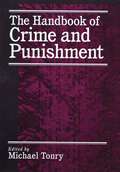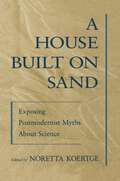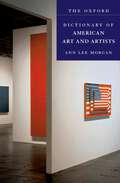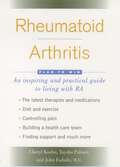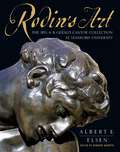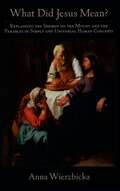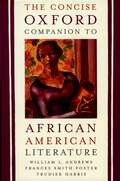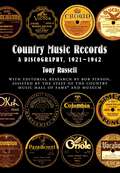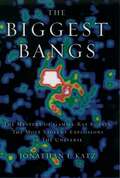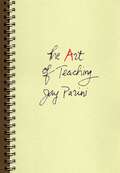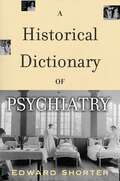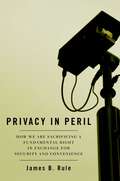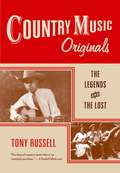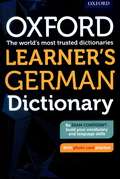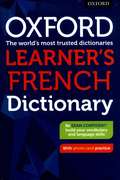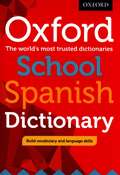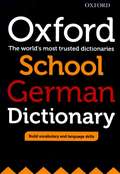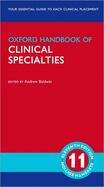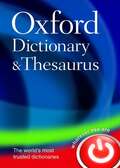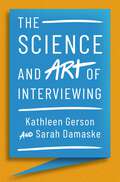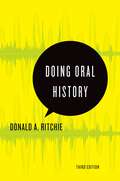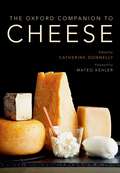- Table View
- List View
The Handbook of Crime and Punishment
by Michael TonryCrime is one of the most significant political issues in contemporary American society. Crime control statistics and punishment policies are subjects of constant partisan debate, while the media presents sensationalized stories of criminal activity and over-crowded prisons. In the highly politicized arena of crime and justice, empirical data and reasoned analysis are often overlook or ignored. The Handbook of Crime and Punishment, however, provides a comprehensive overview of criminal justice, criminology, and crime control policy, thus enabling a fundamental understanding of crime and punishment essential to an informed public. Expansive in its coverage, the Handbook presents materials on crime and punishment trends as well as timely policy issues. The latest research on the demography of crime (race, gender, drug use) is included and weighty current problems (organized crime, white collar crime, family violence, sex offenders, youth gangs, drug abuse policy) are examined. Processes and institutions that deal with accused and convicted criminals and techniques of punishment are also examined. While some articles emphasize American research findings and developments, others incorporate international research and offer a comparative perspective from other English-speaking countries and Western Europe. Editor Michael Tonry, a leading scholar of criminology, introduces the 28 articles in the volume, each contributed by an expert in the field. Designed for a wide audience, The Handbook is encyclopedic in its range and depth of content, yet is written in an accessible style. The most inclusive and authoritative work on the topic to be found in one volume, this book will appeal to those interested in the study of crime and its causes, effects, trends, and institutions; those interested in the forms and philosophies of punishment; and those interested in crime control.
A House Built On Sand: Exposing Postmodernist Myths About Science
by Noretta KoertgeCultural critics say that "science is politics by other means," arguing that the results of scientific inquiry are profoundly shaped by the ideological agendas of powerful elites. They base their claims on historical case studies purporting to show the systematic intrusion of sexist, racist, capitalist, colonialist and/or professional interests into the very content of science. Physicist Alan Sokal recently poked fun at these claims by foisting a sly parody of the genre on the unwitting editors of the cultural studies journal Social Text touching off a still unabated torrent of editorials, articles, and heated classroom and Internet discussion. This hard-hitting collection picks up where Sokal left off. The essayists offer crisp and detailed critiques of case studies offered by the cultural critics as evidence that scientific results tell us more about social context than they do about the natural world. Pulling no punches, they identify numerous crude factual blunders (e.g. that Newton never performed any experiments) and egregious errors of emission, such as the attempt to explain the slow development of fluid dynamics solely in terms of gender bias. Where there are positive aspects of a flawed account, or something to be learned from it, they do not hesitate to say so. Their target is shoddy scholarship. Comprising new essays by distinguished scholars of history, philosophy, and science (including Sokal himself), this book raises a lively debate to a new level of seriousness.
The Oxford Dictionary of American Art and Artists (Oxford Quick Reference)
by Ann Lee MorganWith the advent of abstract expressionism in the 1940s, America became the white hot center of the artistic universe. Now, in The Oxford Dictionary of American Art and Artists, the first such volume to appear in three decades, Ann Lee Morgan offers an informative, insightful, and long overdue resource on our nation's artistic heritage. Featuring 945 alphabetically arranged entries, here is an indispensable biographical and critical guide to American art from colonial times to contemporary postmodernism. Readers will find a wealth of factual detail and insightful analysis of the leading American painters, ranging from John Singleton Copley, Thomas Cole, and Mary Cassatt to such modern masters as Jackson Pollack, Romare Bearden, and Andy Warhol. Morgan offers razor-sharp entries on sculptors ranging from Alexander Calder to Louise Nevelson, on photographers such as Berenice Abbott, Man Ray, Walker Evans, and Ansel Adams, and on contemporary installation artists, including video master Bill Viola. In addition, the dictionary provides entries on important individuals connected to the art scene, including collectors such as Peggy Guggenheim and critics such as Clement Greenberg. Morgan also examines notable American institutions, organizations, schools, techniques, styles, and movements. The range of coverage is indeed impressive, but equally important is the quality of analysis that appears in entry after entry. Morgan gives readers a wealth of trustworthy and authoritative information as well as perceptive, well-informed criticism of artists and their work. In addition, the book is thoroughly cross-referenced, so readers can easily find additional information on any topic of interest. Beautifully written, filled with fascinating historical background and penetrating insight, The Oxford Dictionary of American Art and Artists is an essential one-volume resource for art lovers everywhere.
Rheumatoid Arthritis: Plan to Win
by Cheryl Koehn Taysha Palmer John Esdaile M.D.Nearly 3 million Americans suffer from rheumatoid arthritis, a painful, incurable connective-tissue disease that attacks the hands and feet as well as the joints and may lead to deformities and permanent disabilities. Rheumatoid Arthritis: Plan to Win offers an inspiring, scientifically based game plan for minimizing the effects of this chronic illness, and ultimately, achieving optimal health. Here is the definitive resource for practical strategies and emotional support, whether you need help controlling pain, are concerned about medication side-effects, or want to locate a reliable RA news source or support group on the Internet. Helpful chapters detail the latest therapies, special dietary and exercise needs of people with RA, how to deal with arthritis at home and in the workplace, prepare for surgery, pregnancy and childbirth, enjoy healthy sexuality, use the mind-body connection to control symptoms, make informed decisions about alternative medicine, and perhaps most important, how to build a healthcare team and maintain excellent communication and working relationships with that team. By using this book as a starting point and a 24/7 reference guide, people with RA will be better equipped to form an effective plan of action, making well-informed decisions about their health along the way, and greatly enhancing their ability to live happy, productive lives. Cheryl Koehn, who was an Olympic-caliber athlete when she developed RA, is a leading advocate and spokesperson for people with arthritis. Together with her co-authors, John Esdaile, MD, and science writer Taysha Palmer, Koehn provides a wealth of information and practical advice, assembled from thousands of research papers as well as from her personal experiences with this debilitating disease.
Rodin's Art: The Rodin Collection of Iris & B. Gerald Cantor Center of Visual Arts at Stanford University
by the late Albert E. Elsen Rosalyn Frankel JamisonThe late Albert Elsen was the first American scholar to study seriously the work of the French sculptor Auguste Rodin, and the person most responsible for a revival of interest in the artist as a modern innovator--after years during which the sculpture had been dismissed as so much Victorian bathos. After a fortuitous meeting with the financier, philanthropist, and art collector B. Gerald Cantor, Elsen helped Cantor to build up a major collection of Rodin's work. A large part of this collection, consisting of more than 200 pieces, was donated to the Stanford Museum by Mr. Cantor, who died recently. In size it is surpassed only the by the Musée Rodin in Paris and rivaled only by the collection in Philadelphia. In scope the collection is unique in having been carefully selected to present a balanced view of Rodin's work throughout his life. Rodin's Art encompasses a lifetime's thoughts on Rodin's career, surveying the artist's accomplishments through the detailed discussion of each object in the collection. It will begin with essays on the formation of the collection, the reception of Rodin's work, and his casting techniques. The entries that follow are arranged topically and include extensive discussions of Rodin's major projects.
What Did Jesus Mean?: Explaining The Sermon On The Mount And The Parables In Simple And Universal Human Concepts
by Anna WierzbickaThe Concise Oxford Companion to African American Literature
by William L. Andrews Frances Smith Foster Trudier HarrisThis abridgement of The Oxford Companion to African American Literature will make the entries of the greatest general interest available to a wider audience, providing the same calibre of scholarship and information as the original volume. The Concise collects more than 400 biographies (authors, critics, literary characters and historical figures) of both well-known figures and the lives and careers of writers not found in other reference works. The abridgement also includes the 150 plot summaries of major works. The editors briefly update the biographic details for author entries to include mention of major new works, death dates, and awards since the Companion's 1997 publication. A revised introduction, contributors list, subject index, cross-references, and updated bibliographical notes are also included. The volume reprints in its entirety the five-part fifteen page essay, "Literary History", capturing the full sweep of African American writing in the U.S. from the colonial and early national eras to the present day.
Country Music Records: A Discography, 1921-1942
by Tony Russell Bob PinsonMore than twenty years in the making, Country Music Records documents all country music recording sessions from 1921 through 1942. With primary research based on files and session logs from record companies, interviews with surviving musicians, as well as the 200,000 recordings archived at the Country Music Hall of Fame and Museum's Frist Library and Archives, this notable work is the first compendium to accurately report the key details behind all the recording sessions of country music during the pre-World War II era. This discography documents--in alphabetical order by artist--every commercial country music recording, including unreleased sides, and indicates, as completely as possible, the musicians playing at every session, as well as instrumentation. This massive undertaking encompasses 2,500 artists, 5,000 session musicians, and 10,000 songs. Summary histories of each key record company are also provided, along with a bibliography. The discography includes indexes to all song titles and musicians listed.
The Biggest Bangs: The Mystery of Gamma-ray Bursts, the Most Violent Explosions in the Universe
by Jonathan I. KatzGamma-ray bursts are the most violent events since the birth of the universe. They are about ten times more energetic than the most powerful supernovae. At their peak, gamma-ray bursts are the brightest objects in space, about 100,000 times brighter than an entire galaxy. And yet until recently these titanic eruptions were the most mysterious events in astronomy. In The Biggest Bangs, astrophysicist Jonathan Katz offers a fascinating account of the scientific quest to unravel the mystery of these incredible phenomena. With an eye for colorful detail and a talent for translating scientific jargon into plain English, Katz ranges from the accidental discovery of gamma-ray bursts (by a Cold War satellite system monitoring the Nuclear Test Ban Treaty) to the frustrating but ultimately successful efforts to localize these bursts in distant galaxies. He describes the theories, the equipment (the most recent breakthrough was made with a telescope you could carry under your arm), and the pioneers who have finally begun to explain these strange bursts. And along the way, he offers important lessons about science itself, arguing that "small science" is as valuable as institutionalized "big science," that observations are more the product of advances in technology than of theory, and that theory is only "the concentrated essence of experiment." With the advent of the space age a mere 40 years ago, we have grown used to strangeness in the universe--and confident in science's ability to explain it. In The Biggest Bangs, Jonathan Katz shows that there are still wonders out there that exceed the bounds of our imagination and defy our ability to understand them.
The Art of Teaching
by Jay PariniBecoming an effective teacher can be quite painful and exhausting, taking years of trial and error. In The Art of Teaching, writer and critic Jay Parini looks back over his own decades of trials, errors, and triumphs, in an intimate memoir that brims with humor, encouragement, and hard-won wisdom about the teacher's craft. Here is a godsend for instructors of all levels, offering valuable insight into the many challenges that educators face, from establishing a persona in the classroom, to fostering relationships with students, to balancing teaching load with academic writing and research. Insight abounds. Parini shows, for instance, that there is nothing natural about teaching. The classroom is a form of theater, and the teacher must play various roles. A good teacher may look natural, but that's the product of endless practice. The book also considers such topics as the manner of dress that teachers adopt (and what this says about them as teachers), the delicate question of politics in the classroom, the untapped value of emeritus professors, and the vital importance of a settled, disciplined life for a teacher and a writer. Parini grounds all of this in personal stories of his own career in the academy, tracing his path from unfocused student--a self-confessed "tough nut to crack"--to passionate writer, scholar, and teacher, one who frankly admits making many mistakes over the years. Every year, thousands of newly minted college teachers embark on their careers, most with scant training in their chosen profession. The Art of Teaching is a perfect book for these young educators as well as anyone who wants to learn more about this difficult but rewarding profession.
A Historical Dictionary of Psychiatry
by Edward ShorterThis is the first historical dictionary of psychiatry. It covers the subject from autism to Vienna, and includes the key concepts, individuals, places, and institutions that have shaped the evolution of psychiatry and the neurosciences. An introduction puts broad trends and international differences in context, and there is an extensive bibliography for further reading. Each entry gives the main dates, themes, and personalities involved in the unfolding of the topic. Longer entries describe the evolution of such subjects as depression, schizophrenia, and psychotherapy. The book gives ready reference to when things happened in psychiatry, how and where they happened, and who made the main contributions. In addition, it touches on such social themes as "women in psychiatry," "criminality and psychiatry," and "homosexuality and psychiatry." A comprehensive index makes immediately accessible subjects that do not appear in the alphabetical listing. Among those who will appreciate this dictionary are clinicians curious about the origins of concepts they use in their daily practices, such as "paranoia," "selective serotonin reuptake inhibitors" (SSRIs), or "tardive dyskinesia"; basic scientists who want ready reference to the development of such concepts as "neurotransmitters," "synapse," or "neuroimaging"; students of medical history keen to situate the psychiatric narrative within larger events, and the general public curious about illnesses that might affect them, their families and their communities-or readers who merely want to know about the grand chain of events from the asylum to Freud to Prozac. Bringing together information from the English, French, German, Italian, and Scandinavian languages, the Dictionary rests on an enormous base of primary sources that cover the growth of psychiatry through all of Western society.
Privacy in Peril: How We Are Sacrificing a Fundamental Right in Exchange for Security and Convenience
by James B. RuleThis probing account of the erosion of privacy in America shows that we are often unwitting, if willing, accomplices, providing personal data in exchange for security or convenience. The author shows that the personal data that we make available to virtually any organization for virtually any purpose is apt to surface elsewhere, applied to utterly different purposes. As long as we willingly accept the pursuit of profit or cutting government costs as sufficient reason for intensified scrutiny over our lives, then privacy will remain endangered.
Country Music Originals: The Legends and the Lost
by Tony RussellGraced by more than 200 illustrations, many of them seldom seen and some never before published, this sparkling volume offers vivid portraits of the men and women who created country music, the artists whose lives and songs formed the rich tradition from which so many others have drawn inspiration. Included here are not only such major figures as Jimmie Rodgers, The Carter Family, Fiddlin' John Carson, Charlie Poole, and Gene Autry, who put country music on America's cultural map, but many fascinating lesser-known figures as well, such as Carson Robison, Otto Gray, Chris Bouchillon, Emry Arthur and dozens more, many of whose stories are told here for the first time. To map some of the winding, untraveled roads that connect today's music to its ancestors, Tony Russell draws upon new research and rare source material, such as contemporary newspaper reports and magazine articles, internet genealogy sites, and his own interviews with the musicians or their families. The result is a lively mix of colorful tales and anecdotes, priceless contemporary accounts of performances, illuminating social and historical context, and well-grounded critical judgment. The illustrations include artist photographs, record labels, song sheets, newspaper clippings, cartoons, and magazine covers, recreating the look and feel of the entire culture of country music. Each essay includes as well a playlist of recommended and currently available recordings for each artist. Finally, the paperback edition now features an extensive index.
Oxford Learner's German Dictionary
by OxfordThis revised edition fully supports GCSE students learning German. Up-to-date curriculum coverage with extensive vocabulary, translations and examples enables users to manipulate language confidently. Grammar support includes full verb tables and the illustrated thematic supplement, with photocard activities, prepares students for exams.
Oxford Learner's French Dictionary
by Oxford Dictionaries StaffThis revised edition fully supports GCSE students learning French. Up-to-date curriculum coverage with extensive vocabulary, translations and examples enables users to manipulate language confidently. Grammar support includes full verb tables and the illustrated thematic supplement, with photocard activities, prepares students for exams.
Oxford School Spanish Dictionary
by OxfordAn updated edition for a new generation of students getting to grips with Spanish at primary school and into the first years at secondary school. Clear and easy to use, it is ideal for building vocabulary and cultural knowledge. An extra grammar section of verb tables gives the tenses in Spanish with English translations.
Oxford School German Dictionary
by Oxford Dictionaries Press StaffThis updated edition is ideal for students learning German at primary school and into their first years in secondary school. Clear and easy to use, it is a quick and easy way to expand students' knowledge of German words and phrases. The full verb tables help with recognizing different tenses and build confidence.
Oxford Handbook Of Clinical Specialties (Oxford Medical Handbooks Ser.)
by Andrew BaldwinFor over thirty years, the Oxford Handbook of Clinical Specialties has guided students and junior doctors through their clinical placements, renowned for providing all the information needed for both practice and revision in a deceptively small package. Now in its eleventh edition, the Handbook has been revitalized by an expanded team of specialty experts and junior doctors to guide readers through each of the specialties encountered through medical school and Foundation Programme rotations, while remaining true to the humanity and patient focus of the original edition. Updated with the latest advice and clinical guidelines, packed full of high-quality illustrations, boxes, tables, and classifications, and with a brand new chapter on how to survive your junior doctor years and beyond, this handbook is ideal for both study and use at direct point of care. Each chapter is clear and concise and filled with medical gems, with features including ribbons to mark your most-used pages and mnemonics to help you memorize and retain key facts. With reassuring and friendly advice throughout, this is the ultimate guide and revision tool for every medical student and junior doctor for each clinical specialty placement. This well-loved Handbook remains the perfect companion to the Oxford Handbook of Clinical Medicine, together encompassing the entire spectrum of clinical medicine and unmatched by any competitor in their class, helping you become the doctor you want to be.
Oxford Handbook Of Clinical Specialties (Oxford Medical Handbooks Ser. (PDF))
by Andrew BaldwinFor over thirty years, the Oxford Handbook of Clinical Specialties has guided students and junior doctors through their clinical placements, renowned for providing all the information needed for both practice and revision in a deceptively small package. Now in its eleventh edition, the Handbook has been revitalized by an expanded team of specialty experts and junior doctors to guide readers through each of the specialties encountered through medical school and Foundation Programme rotations, while remaining true to the humanity and patient focus of the original edition.
Oxford Dictionary And Thesaurus: (pdf)
by Judy Pearsall Oxford Dictionaries StaffThe second edition of the Oxford Dictionary and Thesaurus is the perfect language resource, combining a dictionary and thesaurus text. This means that you only have to reach for one book when you need language help. In this edition the dictionary and thesaurus texts are integrated so that the thesaurus entry for a word follows the dictionary entry directly. This is based on market research into user preferences making the dictionary accessible, clear, and easy to use. New to this edition is a centre section for crossword enthusiasts and puzzle solvers, containing hundreds of thematic word lists. With 300,000 definitions, synonyms, and antonyms, this really is the ultimate tool for anyone who loves language-based quizzes and puzzles. The Oxford Dictionary and Thesaurus also features usage notes to help you deal with tricky vocabulary and improve your writing style. The ultimate reference tool for your shelf - but not designed to stay there!
The Science and Art of Interviewing
by Kathleen Gerson Sarah DamaskeQualitative interviewing is among the most widely used methods in the social sciences, but it is arguably the least understood. In The Science and Art of Interviewing, Kathleen Gerson and Sarah Damaske offer clear, theoretically informed and empirically rich strategies for conducting interview studies. They present both a rationale and guide to the science-and art-of in-depth interviewing to take readers through all the steps in the research process, from the initial stage of formulating a question to the final one of presenting the results. Gerson and Damaske show readers how to develop a research design for interviewing, decide on and find an appropriate sample, construct a questionnaire, conduct probing interviews, and analyze the data they collect. At each stage, they also provide practical tips about how to address the ever-present, but rarely discussed challenges that qualitative researchers routinely encounter, particularly emphasizing the relationship between conducting well-crafted research and building powerful social theories. With an engaging, accessible style, The Science and Art of Interviewing targets a wide range of audiences, from upper-level undergraduates and graduate methods courses to students embarking on their dissertations to seasoned researchers at all stages of their careers.
SCIENCE & ART OF INTERVIEWING C
by Kathleen Gerson Sarah DamaskeQualitative interviewing is among the most widely used methods in the social sciences, but it is arguably the least understood. In The Science and Art of Interviewing, Kathleen Gerson and Sarah Damaske offer clear, theoretically informed and empirically rich strategies for conducting interview studies. They present both a rationale and guide to the science-and art-of in-depth interviewing to take readers through all the steps in the research process, from the initial stage of formulating a question to the final one of presenting the results. Gerson and Damaske show readers how to develop a research design for interviewing, decide on and find an appropriate sample, construct a questionnaire, conduct probing interviews, and analyze the data they collect. At each stage, they also provide practical tips about how to address the ever-present, but rarely discussed challenges that qualitative researchers routinely encounter, particularly emphasizing the relationship between conducting well-crafted research and building powerful social theories. With an engaging, accessible style, The Science and Art of Interviewing targets a wide range of audiences, from upper-level undergraduates and graduate methods courses to students embarking on their dissertations to seasoned researchers at all stages of their careers.
Doing Oral History (Oxford Oral History Series)
by Donald A. RitchieDoing Oral History is considered the premier guidebook to oral history, used by professional oral historians, public historians, archivists, and genealogists as a core text in college courses and throughout the public history community. Over the past decades, the development of digital audio and video recording technology has continued to alter the practice of oral history, making it even easier to produce quality recordings and to disseminate them on the Internet. This basic manual offers detailed advice on setting up an oral history project, conducting interviews, making video recordings, preserving oral history collections in archives and libraries, and teaching and presenting oral history. Using the existing Q&A format, the third edition asks new questions and augments previous answers with new material, particularly in these areas: 1. Technology: As before, the book avoids recommending specific equipment, but weighs the merits of the types of technology available for audio and video recording, transcription, preservation, and dissemination. Information about web sites is expanded, and more discussion is provided about how other oral history projects have posted their interviews online. 2. Teaching: The new edition addresses the use of oral history in online teaching. It also expands the discussion of Institutional Review Boards (IRBs) with the latest information about compliance issues. 3. Presentation: Once interviews have been conducted, there are many opportunities for creative presentation. There is much new material available on innovative forms of presentation developed over the last decade, including interpretive dance and other public performances. 4. Legal considerations: The recent Boston College case, in which the courts have ruled that Irish police should have access to sealed oral history transcripts, has re-focused attention on the problems of protecting donor restrictions. The new edition offers case studies from the past decade. 5. Theory and Memory: As a beginner's manual, Doing Oral History has not dealt extensively with theoretical issues, on the grounds that these emerge best from practice. But the third edition includes the latest thinking about memory and provides a sample of some of the theoretical issues surrounding oral sources. It will include examples of increased studies into catastrophe and trauma, and the special considerations these have generated for interviewers. 6. Internationalism: Perhaps the biggest development in the past decade has been the spreading of oral history around the world, facilitated in part by the International Oral History Association. New oral history projects have developed in areas that have undergone social and political upheavals, where the traditional archives reflect the old regimes, particularly in Eastern Europe, the Middle East, Asia, Africa, and Latin America. The third edition includes many more references to non-U.S. projects that will still be relevant to an American audience. These changes make the third edition of Doing Oral History an even more useful tool for beginners, teachers, archivists, and all those oral history managers who have inherited older collections that must be converted to the latest technology.
Doing Oral History (Oxford Oral History Series)
by Donald A. RitchieDoing Oral History is considered the premier guidebook to oral history, used by professional oral historians, public historians, archivists, and genealogists as a core text in college courses and throughout the public history community. Over the past decades, the development of digital audio and video recording technology has continued to alter the practice of oral history, making it even easier to produce quality recordings and to disseminate them on the Internet. This basic manual offers detailed advice on setting up an oral history project, conducting interviews, making video recordings, preserving oral history collections in archives and libraries, and teaching and presenting oral history. Using the existing Q&A format, the third edition asks new questions and augments previous answers with new material, particularly in these areas: 1. Technology: As before, the book avoids recommending specific equipment, but weighs the merits of the types of technology available for audio and video recording, transcription, preservation, and dissemination. Information about web sites is expanded, and more discussion is provided about how other oral history projects have posted their interviews online. 2. Teaching: The new edition addresses the use of oral history in online teaching. It also expands the discussion of Institutional Review Boards (IRBs) with the latest information about compliance issues. 3. Presentation: Once interviews have been conducted, there are many opportunities for creative presentation. There is much new material available on innovative forms of presentation developed over the last decade, including interpretive dance and other public performances. 4. Legal considerations: The recent Boston College case, in which the courts have ruled that Irish police should have access to sealed oral history transcripts, has re-focused attention on the problems of protecting donor restrictions. The new edition offers case studies from the past decade. 5. Theory and Memory: As a beginner's manual, Doing Oral History has not dealt extensively with theoretical issues, on the grounds that these emerge best from practice. But the third edition includes the latest thinking about memory and provides a sample of some of the theoretical issues surrounding oral sources. It will include examples of increased studies into catastrophe and trauma, and the special considerations these have generated for interviewers. 6. Internationalism: Perhaps the biggest development in the past decade has been the spreading of oral history around the world, facilitated in part by the International Oral History Association. New oral history projects have developed in areas that have undergone social and political upheavals, where the traditional archives reflect the old regimes, particularly in Eastern Europe, the Middle East, Asia, Africa, and Latin America. The third edition includes many more references to non-U.S. projects that will still be relevant to an American audience. These changes make the third edition of Doing Oral History an even more useful tool for beginners, teachers, archivists, and all those oral history managers who have inherited older collections that must be converted to the latest technology.
The Oxford Companion to Cheese (Oxford Companions)
by Dr Catherine DonnellyWinner of the 2017 James Beard Award for Reference & Scholarship The discovery of cheese is a narrative at least 8,000 years old, dating back to the Neolithic era. Yet, after all of these thousands of years we are still finding new ways to combine the same four basic ingredients - milk, bacteria, salt, and enzymes - into new and exciting products with vastly different shapes, sizes, and colors, and equally complex and varied tastes, textures, and, yes, aromas. In fact, after a long period of industrialized, processed, and standardized cheese, cheesemakers, cheesemongers, affineurs, and most of all consumers are rediscovering the endless variety of cheeses across cultures. The Oxford Companion to Cheese is the first major reference work dedicated to cheese, containing 855 A-Z entries on cheese history, culture, science, and production. From cottage cheese to Camembert, from Gorgonzola to Gruyère, there are entries on all of the major cheese varieties globally, but also many cheeses that are not well known outside of their region of production. The concentrated whey cheeses popular in Norway, brunost, are covered here, as are the traditional Turkish and Iranian cheeses that are ripened in casings prepared from sheep's or goat's skin. There are entries on animal species whose milk is commonly (cow, goat, sheep) and not so commonly (think yak, camel, and reindeer) used in cheesemaking, as well as entries on a few highly important breeds within each species, such as the Nubian goat or the Holstein cow. Regional entries on places with a strong history of cheese production, biographies of influential cheesemakers, innovative and influential cheese shops, and historical entries on topics like manorial cheesemaking and cheese in children's literature round out the Companion's eclectic cultural coverage. The Companion also reflects a fascination with the microbiology and chemistry of cheese, featuring entries on bacteria, molds, yeasts, cultures, and coagulants used in cheesemaking and cheese maturing. The blooms, veins, sticky surfaces, gooey interiors, crystals, wrinkles, strings, and yes, for some, the odors of cheese are all due to microbial action and growth. And today we have unprecedented insight into the microbial complexity of cheese, thanks to advances in molecular biology, whole-genome sequencing technologies, and microbiome research. The Companion is equally interested in the applied elements of cheesemaking, with entries on production methodologies and the technology and equipment used in cheesemaking. An astonishing 325 authors contributed entries to the Companion, residing in 35 countries. These experts included cheesemakers, cheesemongers, dairy scientists, anthropologists, food historians, journalists, archaeologists, and on, from backgrounds as diverse as the topics they write about. Every entry is signed by the author, and includes both cross references to related topics and further reading suggestions. The endmatter includes a list of cheese-related museums and a thorough index. Two 16-page color inserts and well over a hundred black and white images help bring the entries to life. This landmark encyclopedia is the most wide-ranging, comprehensive, and reliable reference work on cheese available, suitable for both novices and industry insiders alike.
